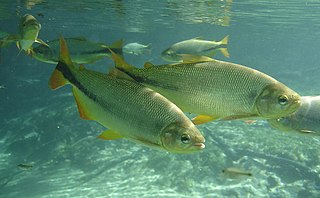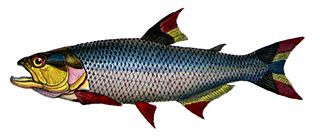
Characidae, the characids or characins is a family of freshwater subtropical and tropical fish, belonging to the order Characiformes. The name "characins" is the historical one, but scientists today tend to prefer "characids" to reflect their status as a by and large monophyletic group at family rank. To arrive there, this family has undergone much systematic and taxonomic change. Among those fishes that remain in the Characidae for the time being are the tetras, comprising the very similar genera Hemigrammus and Hyphessobrycon, as well as a few related forms such as the cave and neon tetras. Fish of this family are important as food and also include popular aquarium fish species.

Hyphessobrycon is a genus of freshwater fish in the family Characidae. These species are among the fishes known as tetras. The genus is distributed in the Neotropical realm from southern Mexico to Río de la Plata in Argentina. Many of these species are native to South America; about six species are from Central America and a single species, H. compressus is from southern Mexico.

Astyanax is a genus of freshwater fish in the family Characidae of the order Characiformes. Some of these fish, like many of their relatives, are kept as aquarium pets and known collectively as tetras. With around 150 described species and new ones being described yearly, this genus is among the largest of the entire order; Hyphessobrycon also has more than 145 species and which one is larger at any one time depends on whether more species have been recently described in one or the other. The blind and colorless cave tetra of Mexico is a famous member of the genus, but its taxonomic position is disputed: Some recognize it as part of the Mexican tetra and this is supported by phylogenetic evidence, but others recognize the cave form as a separate species, A. jordani.

Alestes is a genus in the family Alestidae, known as the "African Characidae" as they are found exclusively on that continent. As suggested by that name, they Alestidae was formerly included in Characidae. Myletes is a synonym of Alestes, but the former name has historically also been used for various South American serrasalmines.

Brycinus is a genus of ray-finned fish in the family Alestiidae. Like other "African characids", they were formerly included in the Characidae but are actually somewhat more distantly related Characiformes.

Brycon is a genus of fish in the family Characidae found in freshwater habitats in Central and South America, ranging from southern Mexico to northern Argentina. Despite not being closely related to true trout, they are sometimes called South American trout. Members of the genus may also be referred to as piraputanga. They reach a maximum length of 11.9–79.5 cm (4.7–31.3 in) depending on the species involved. Some species perform seasonal breeding migrations.

Bryconops is a genus of fish in the family Characidae from South America.

Moenkhausia is a genus of freshwater fish in the family Characidae native to tropical and subtropical South America. These are medium-sized tetras where the largest species only reach around 12 cm (4.7 in).

Salminus, popularly known as dorado or dourado, is a genus of relatively large, predatory freshwater fish from the family Characidae. They are native to large tropical and subtropical rivers in South America, and undertake migrations during the rainy season to spawn. They are very popular among recreational anglers and also support important commercial fisheries.
Atopomesus pachyodus is a species of fish in the family Characidae endemic to the Rio Negro drainage, Amazon basin. This species is the only member of its genus.
Chrysobrycon is a genus of characins endemic to South America.

Gephyrocharax is a genus of characins found in South America and Panama.

Hemigrammus is a genus of freshwater fish in the family Characidae native to South America and commonly seen in the aquarium trade. These are medium-small tetras where the largest species reach up to around 11 cm (4.3 in).
Phallobrycon is a genus of fish in the family Characidae endemic to Brazil.
Rhinopetitia is a genus of characins endemic to Brazil.
Serrapinnus is a genus of characins from tropical South America.

Tetragonopterus is a genus of fish in the family Characidae native to South America.
Xenurobrycon is a genus of characins from tropical South America.
Carlastyanax aurocaudatus is a species of fish in the family Characidae native to the Río Cauca in Colombia. C. aurocaudatus is distinguished by several diagnostic morphological features, especially the presence of a hooked third dentary tooth. This species is the only member of its genus.
Protocheirodon pi, is a South American species of fish in the family Characidae found in Amazonas-Solimões, Purus, Madeira and Ucayali rivers. This species is the only member of its genus.











